Panama: Pygmy Sloths and Rainforest Rodents, May 2022
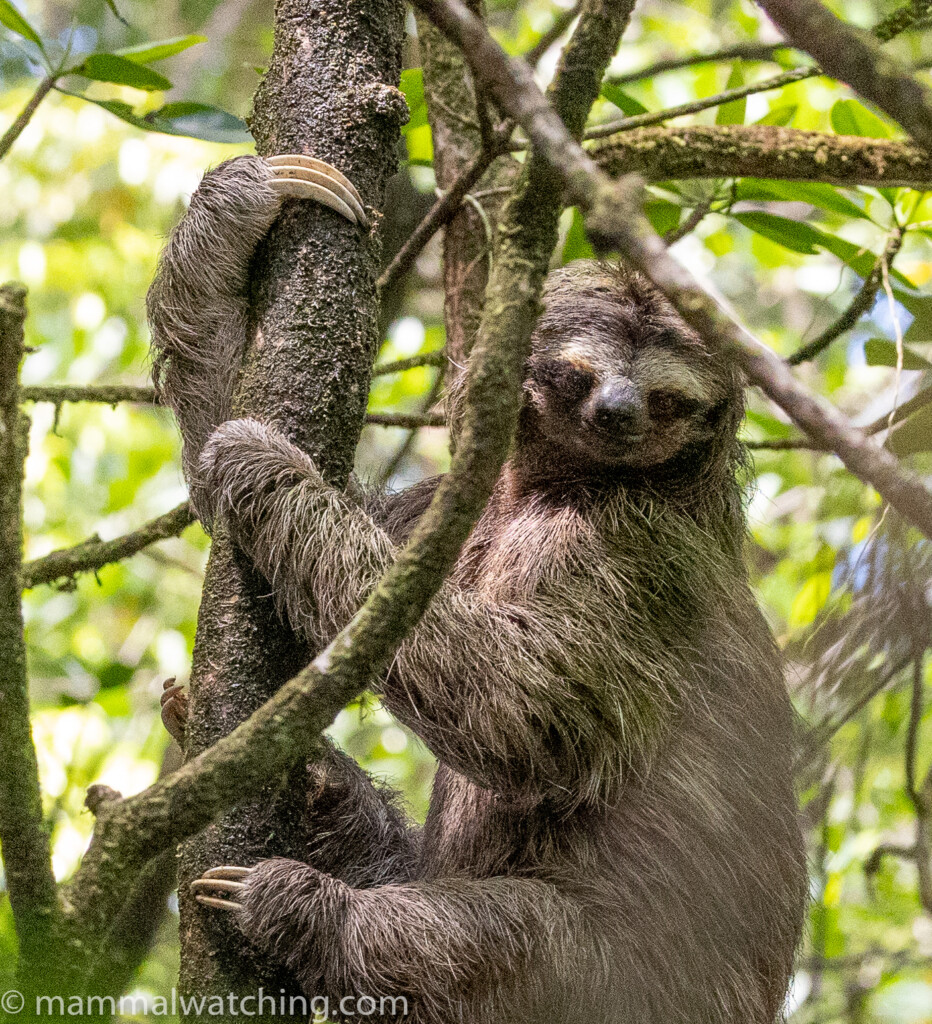
Pygmy Three-toed Sloth, Bradypus pygmaeus. Isla Escudo de Veraguas
In May 2022 I returned to Panama for a week. This, my third trip to the country, was not really a mammalwatching trip per se. I was there to see friends. Yes, really, I have friends who aren’t mammalwatchers. Though they have been known watch me watching mammals. Luqman, who now lives in Panama, and Sion, who lives in the UK went to Superagui Island in 2018 so I figured that they were ready for another mammal-lite trip. The trip guidelines were:
- It should involve a quest to a remote tropical paradise in search of a charismatic species.
- Important to the overall harmony of the trip and our ongoing friendship was that the rum to species ratio hovered around 40 units/mammal.
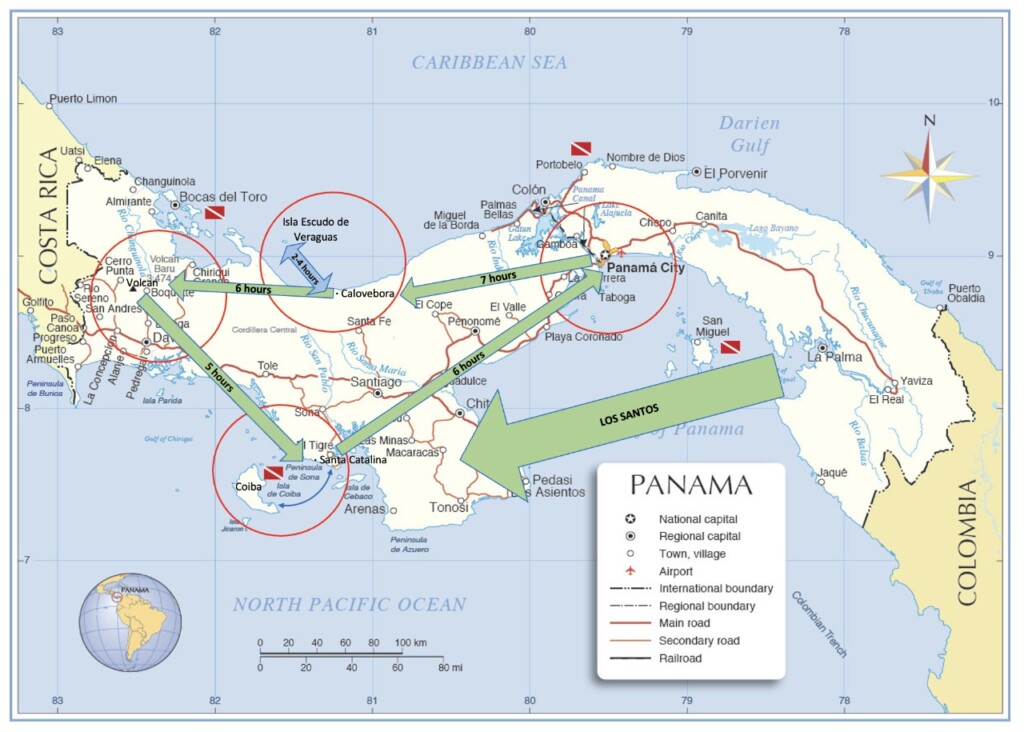
We would start in Isla Escudo de Veraguas to search for the very rare Pygmy Sloth (the only sloth I hadn’t seen); swing by Los Quetzales Lodge in the Cloud Forest near Volcan en route to diving off of Coiba Island; and end with a night at El Valle before returning to Panama City. We considered visiting Los Santos too after rumours of Bush Dogs there (hence the big green arrow). But the rumours were too vague to be realistic. I also spent a couple of nights in the rainforest at Gamboa on my own.
I won’t give much information on most of the trip as destinations are well covered in my and other’s reports. But I will provide some detail on Isla Escudo de Veraguas which is more of a challenge to visit.
Isla Escudo de Veraguas
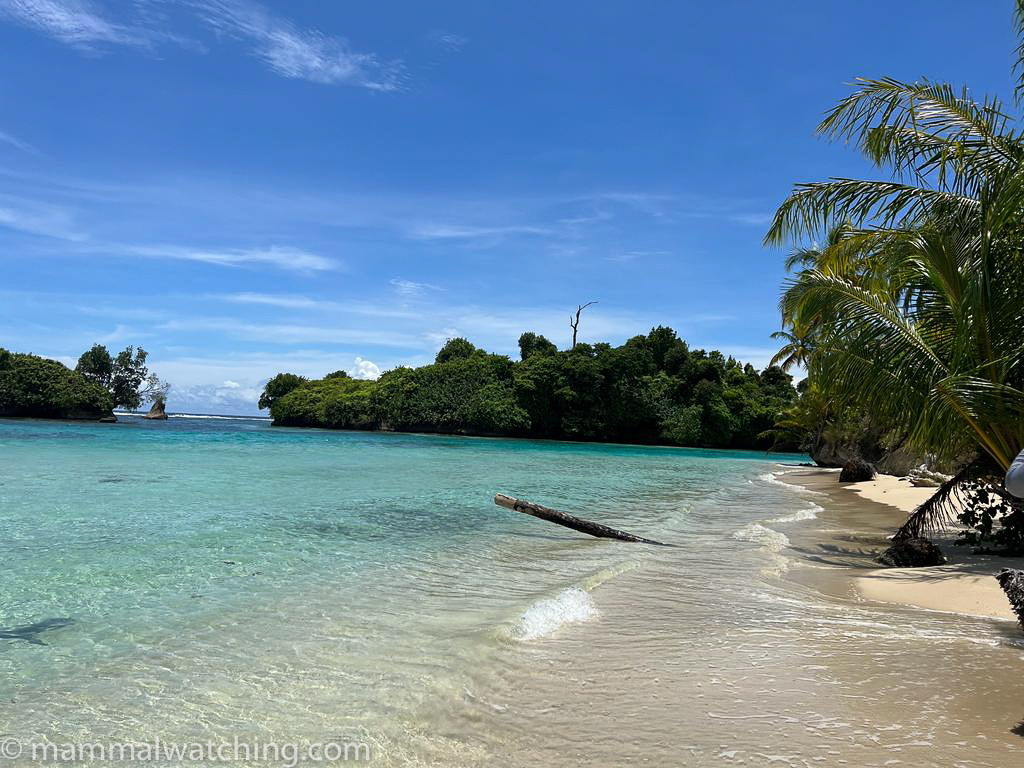
Escudo de Veraguas is a very small – 4km square – Caribbean island about 10 miles offshore. Though it has been isolated from the mainland for only 10,000 years it now boasts its own sloth species: Pygmy Sloths are found only on this island, and only within the island’s 10 hectares of mangrove forest. There are thought to be fewer than 80 of them.
Logistics
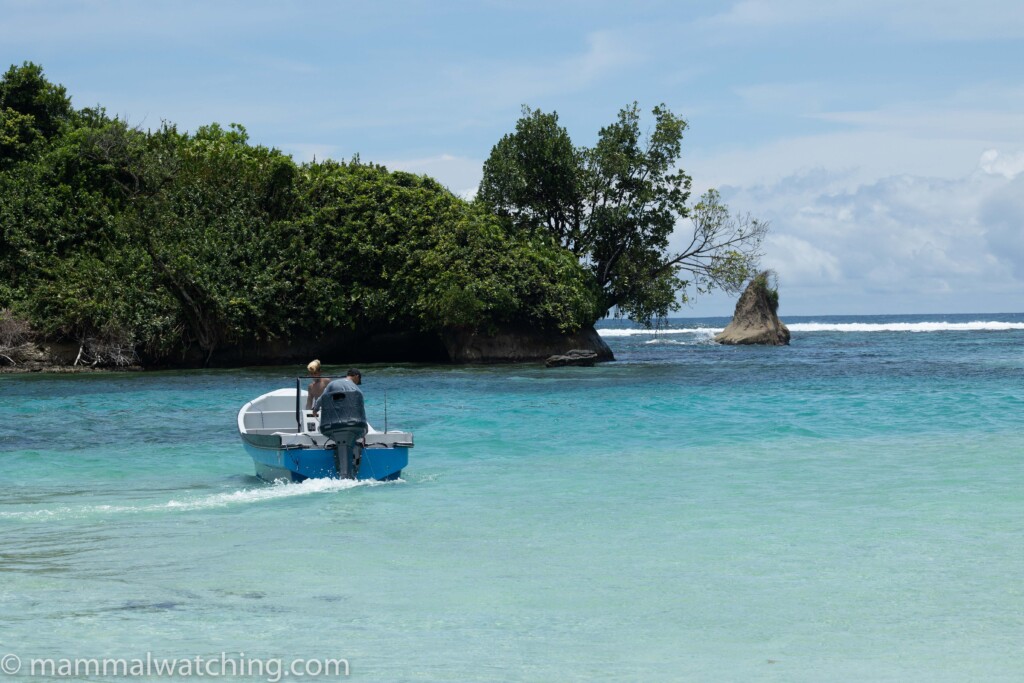
My buddy Luqman, who lives in Panama, organised the trip to the Escudo. He organised it through a tour operator based in Panama City. The tour operator appeared to do very little other than call the boatman and give us the two smallest and cheapest tents in Panama. Possibly in the Americas. So I recommend you deal direct with the boatman. His nickname is Mello (prounced Mayo) and you can reach him on Whatsapp at +507 6530 5000. He doesn’t speak English.
Mello lives on the mainland, and is one of the local Ngäbe-Buglé people who own Escudo. We saw a few fisherman on the island. They were all related to Mello.
He has a decent boat with a large engine and on a calm day can get to the island in under an hour from the mainland village of Calovébora. On a rough day it can take considerably longer. Seas are often calmer in the morning.
It takes about 8 hours driving from Panama City to reach Calovébora, and the road is now asphalt all the way (even if it doesn’t look that way on Google Maps). The village itself is just a small store and a hostel (which ought to be a useful place to stay before a trip to the island).
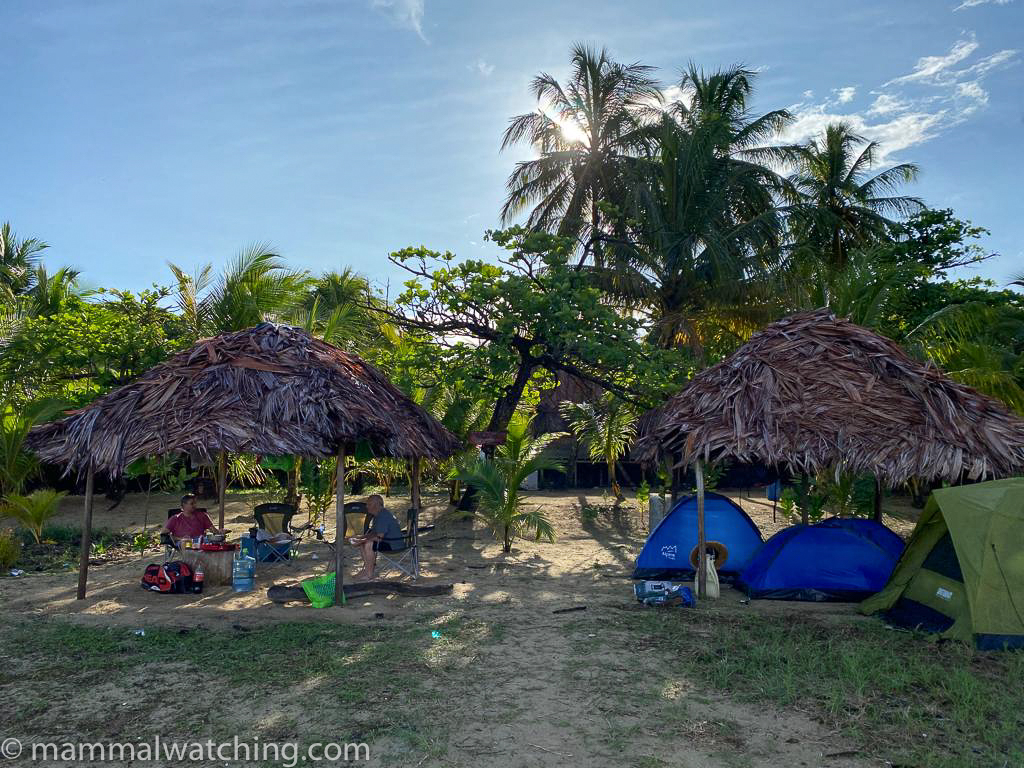
Escudo glamping
You need to take pretty much everything with you.
A few fishermen have cabins on the island. There were rumours we could buy fresh lobster from them but they failed to catch any when we put in an order. Our boatman had a few cannisters of camping gas but ran out 24 hours into our stay. Fortunately he was able to start a camp fire. And there are some thatched shelters – built more for shade than for rain – that you can pitch a tent or a hammock under: in fact a hammock might be the way to go as there were very few bugs.
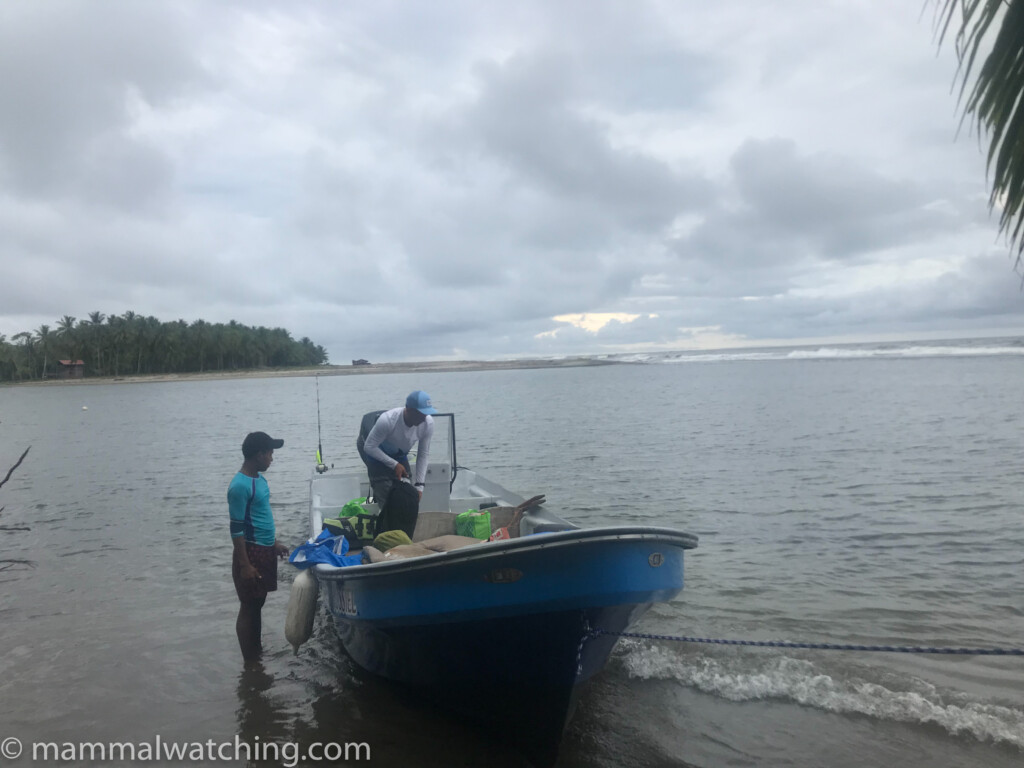
We spent two nights on the island. We arrived in Calovébora in the late afternoon, transferred an enormous quantity of stuff (mainly beer and rum) to the boat and set off for Escudo around 5pm. There was a solid amount of surf rolling into the beach but Mello skillfully navigated it. The hour and half to the island was choppy and we were all very wet when we arrived just before dark (a dry bag is essential if you have a camera).
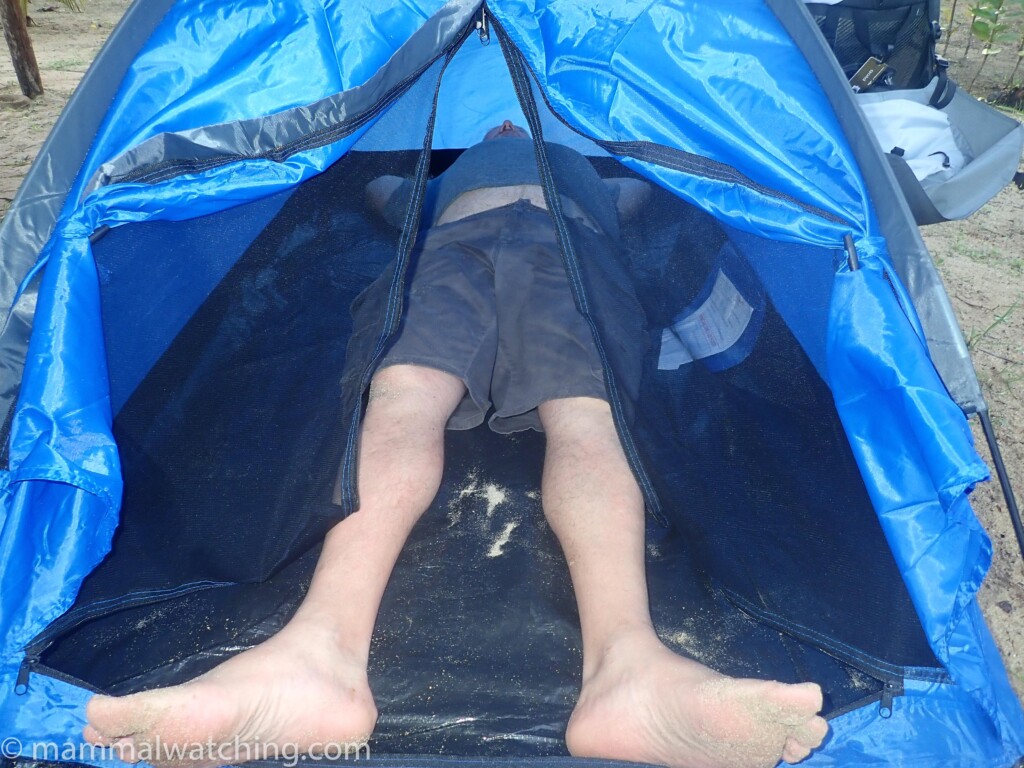
Tiny tent
The four of us were given two tents by the “tour operator” that “we could share”. Sceptical that our friendships would survive two nights sharing a tent in the tropics, we found a couple more.
This was an inspired move. When we unpacked the tents the tour operator had provided we discovered they were barely big enough for an agoraphobic toddler. Too short to lie flat in and barely wide enough for one person. If you could sit up in it you would qualify for an audition with Cirque de Soleil. And we had been expected to share them! They also leaked.
We camped on a beach on the north side of the island. This was mainly for convenience: we were next to Mello’s hut. The beaches on this side of the island were covered in masses of rotting brown Sargassum seaweed – the stuff that is blighting the Caribbean.
May is the start of the rainy season in Panama. It bucketed down both nights. I pitched my tent under the thatched shelter and stayed dry. The others camped in the open and regretted. Their tents had internal water features the next morning.
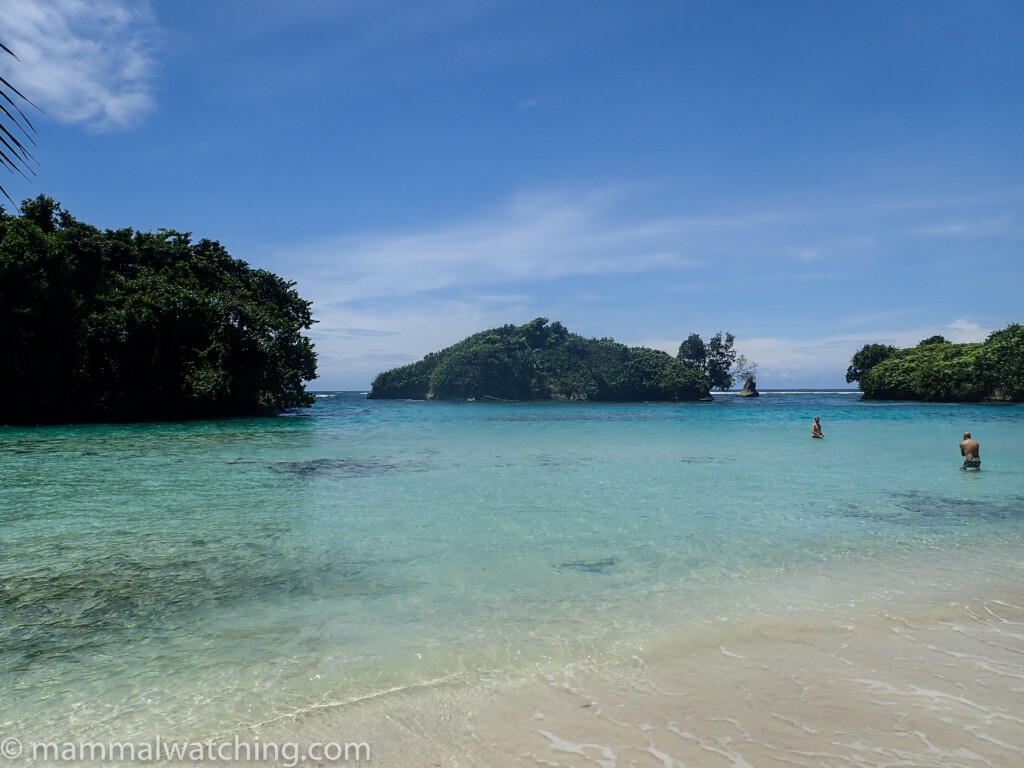
But we had perfect weather for our day on the island. And it is stunning, especially the southern side. I think it is the most beautiful tropical island I have ever seen. Even without the sloths it would be worth a visit.
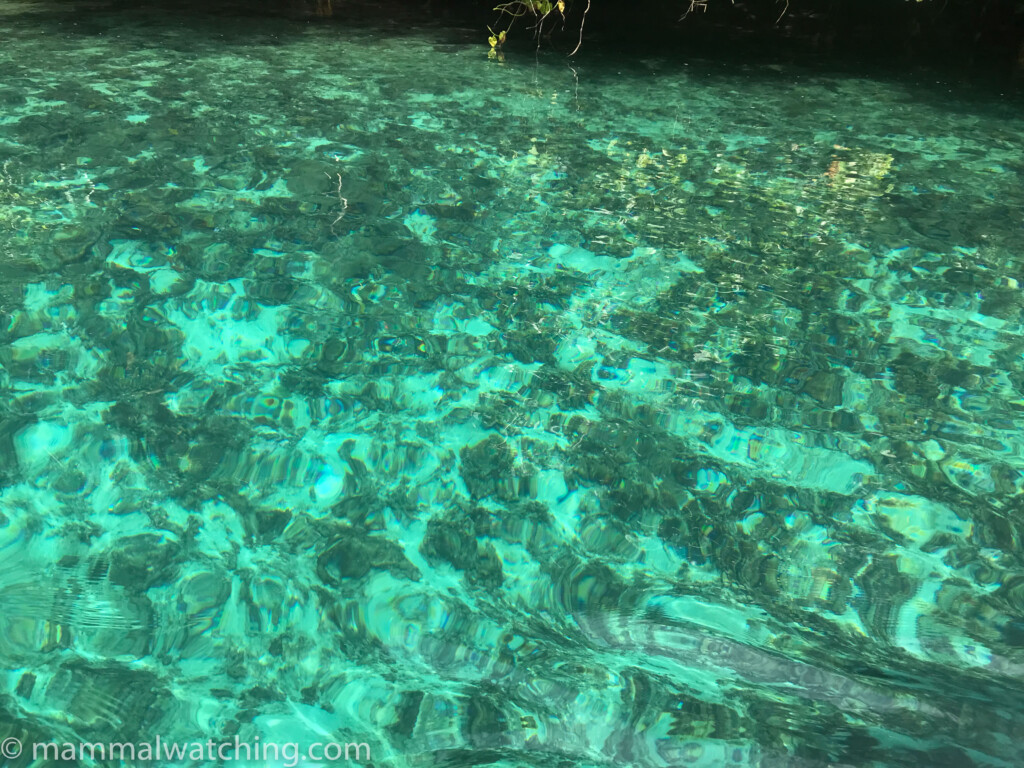
The non-sleeping aspect of the camping was good. Mainly because Mike, the fourth member of our group, cooked up a feast both nights. But from a mammalwatching point of view there is no real need to stay overnight and it would be a lot simpler to visit on a full day trip from Calovébora. We arrived at dusk and left at dawn so we only had one full day on the island in any case.
Mello said he charges $550 to take people over for a day. The boat ought to fit 8 people. You could set off at dawn, spend a happy day on the island, snorkelling and sloth spotting, and be back in Calovébora before dark to drive to a hotel Santiago.
If you wanted to stay closer to the island then it sounded like Mello was building some cabanas on the mainland (I think directly opposite the island) which would half the time to reach the island. The cabanas looked pretty decent from the pictures he showed us.
Alternatively you can follow in our footsteps and visit for a weekend. Mello charges $800 for this.
The Sloths
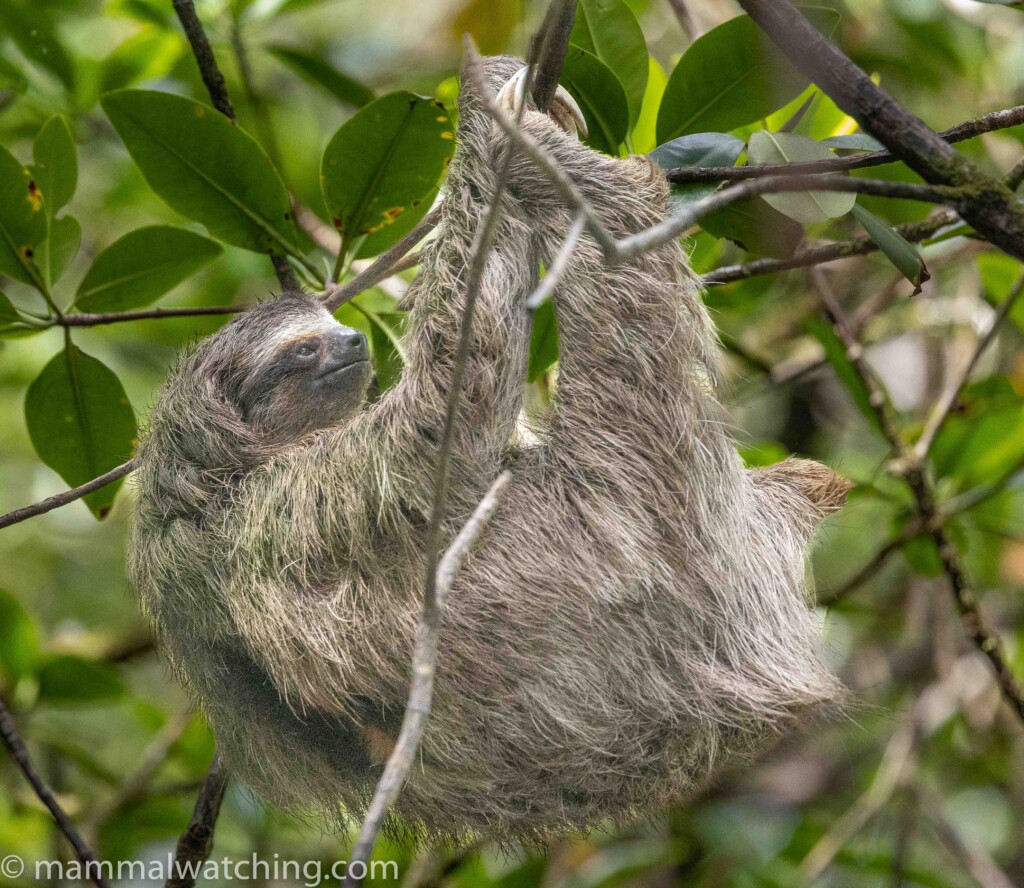
Pygmy Three-toed Sloth, Bradypus pygmaeus
The Pygmy Sloths themselves were pretty easy to find, even if there are thought to be fewer than 80 on the island.
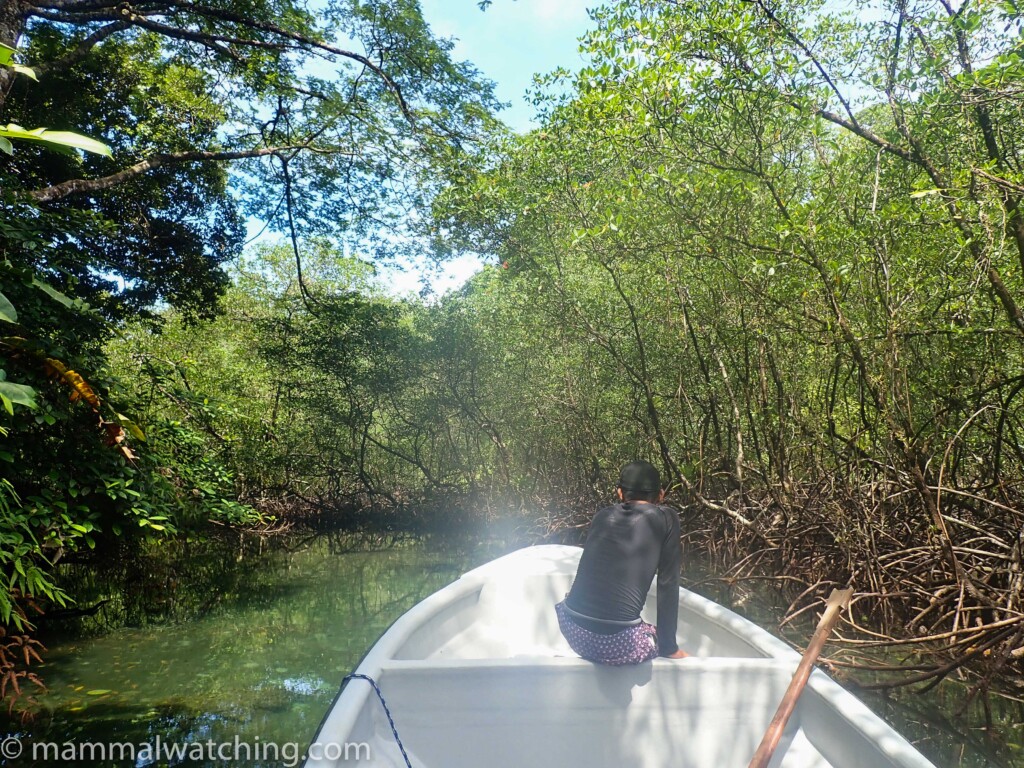
Pygmy Sloth habitat
They are confined to the mangroves and Mello knew where to look for them as I imagine would any boatman. We saw one animal in the late morning after 45 minutes of searching. Here is a video of the energetic sloth in action. And here is another of us first spotting him.
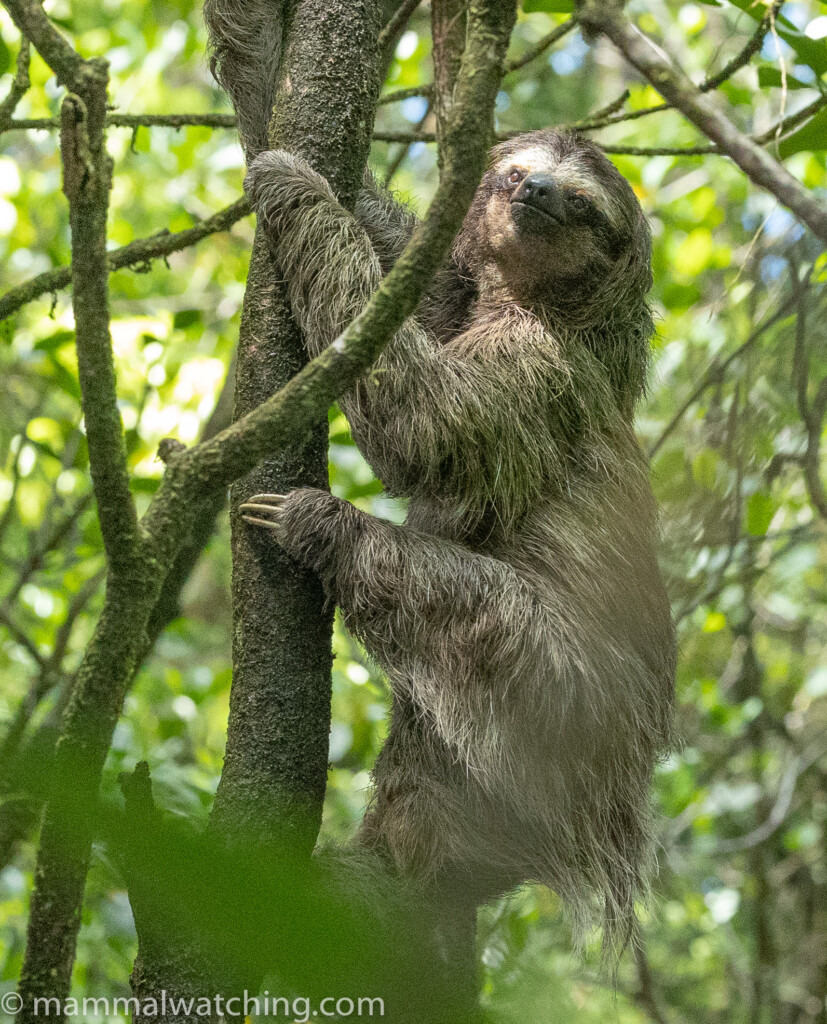
Pygmy Three-toed Sloth, Bradypus pygmaeus
In the afternoon we briefly searched the same area again without success. We stopped at a beach near mangroves for a swim. When I got out of the water one of Mello’s friends was walking down the beach proudly holding a sloth he had plucked from the trees. We diplomatically explained that we didn’t want to disturb the animal and I am sure he realised, from the less diplomatic looks on our faces, that we were horrified. So he immediately returned it to the trees. Judging by some of the photos online this is not an uncommon way to please tourists.
Los Quetzales Lodge, Cerro Punta
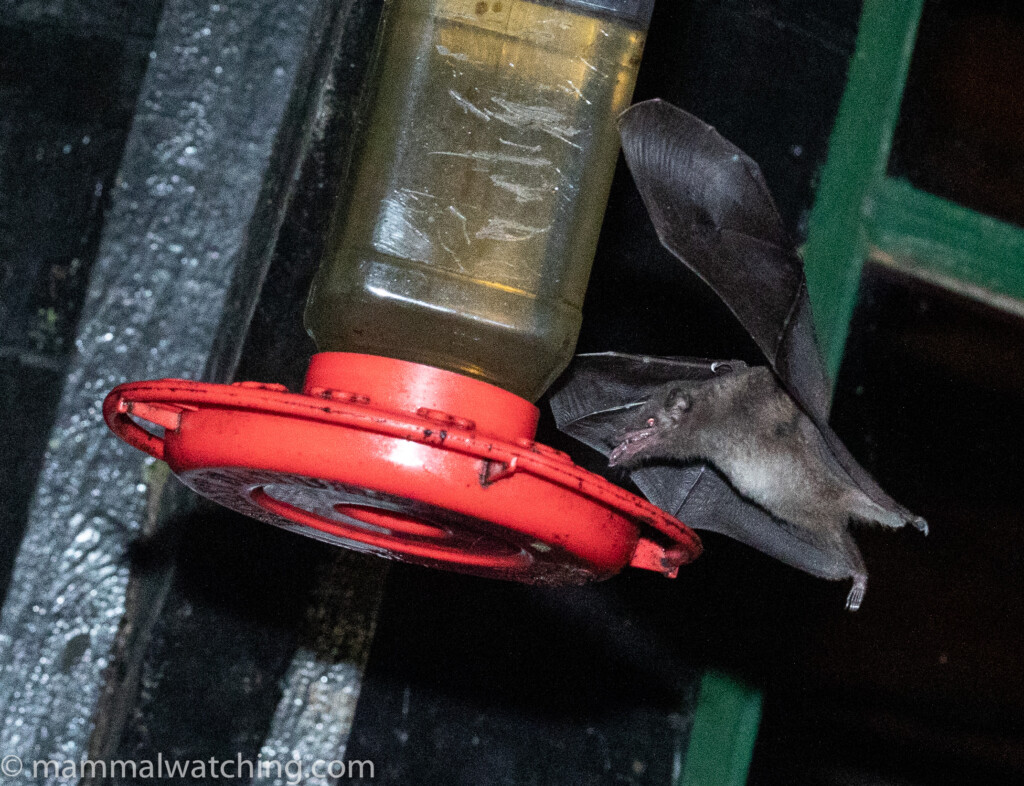
Handley’s Tailless Bat, Anoura cultrata
I visited Los Quetzales in 2016 with my kids, primarily to see Cacomistles which were almost guaranteed at two of the cabins at the top of the property. After I visited there were reports of the hotel falling into disrepair and that the Cacomistles no longer visited. I am happy to report that both the hotel and the Cacomistles are alive and well.
I thought my buddies would enjoy the lodge and the cloud forest. Though I didn’t have any particular mammal targets I wanted to try to catch rodents as the trapping was pretty good in 2016.
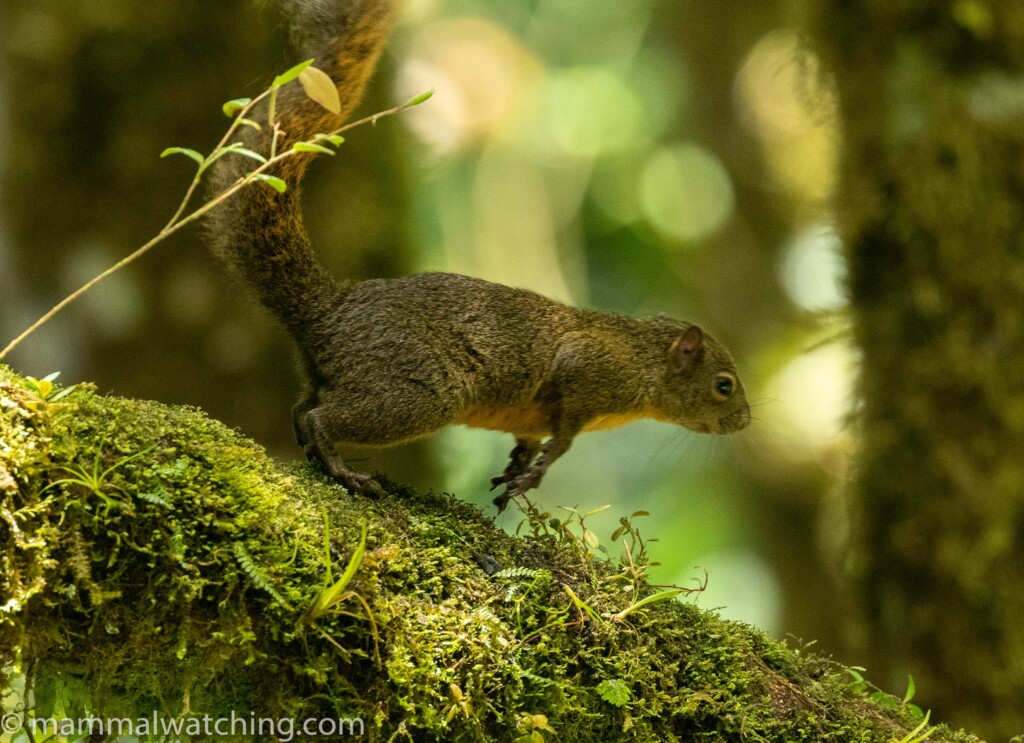
Red-tailed Squirrel, Sciurus granatensis
Luqman insisted on driving up the road to the cabin. Mainly because he thought it would be fun. We made it. Just. But we had a solid 4WD. Alternatively the lodge will drive you up there and collect you when you leave.
I tried to book Cabin 8 (which used to be the best spot for the Cacomistles) but was told it was booked. And so we stayed in Cabin 9 next door. In fact Cabin 8 was empty and as soon as I walked over there on our first evening – not long after dusk – I saw two Cacomistles hanging off of the humming bird feeder guzzling nectar. Later that evening I saw another from the balcony of Cabin 9. It had come to eat the bananas the lodge gave us to put out.
I saw a bat – or bats – at Cabin 8’s nectar feeders. Fiona Reid identified them as Handley’s Tailless Bat.
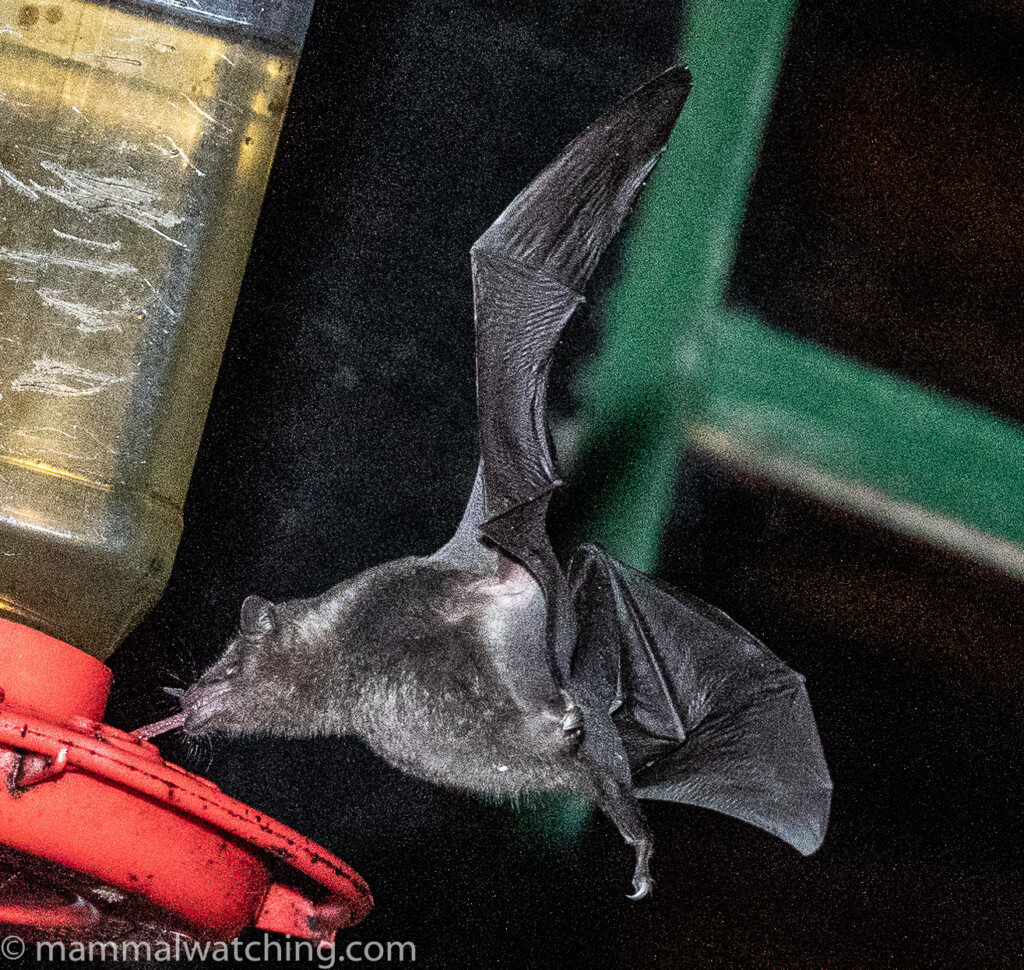
Handley’s Tailless Bat, Anoura cultrata
Red-tailed Squirrels were active around the cabin. At dawn I saw what may have been an Alfaro’s Pygmy Squirrel, though I didn’t see it well enough to be sure it wasn’t just a red-tailed.
I foolishly didn’t make an effort to look for Bang’s Mountain Squirrel which Charles Foley saw here. I had forgotten about his report. If I had remembered I would have spent more time on the Las Minas trail where Charles saw several squirrels: this is a species I only glimpsed in Costa Rica.
Once again I saw diurnal Chiriqui Singing Mice. This one was feeding on the patio below Cabin 9’s balcony and appeared to be denning under a crack in the concrete.
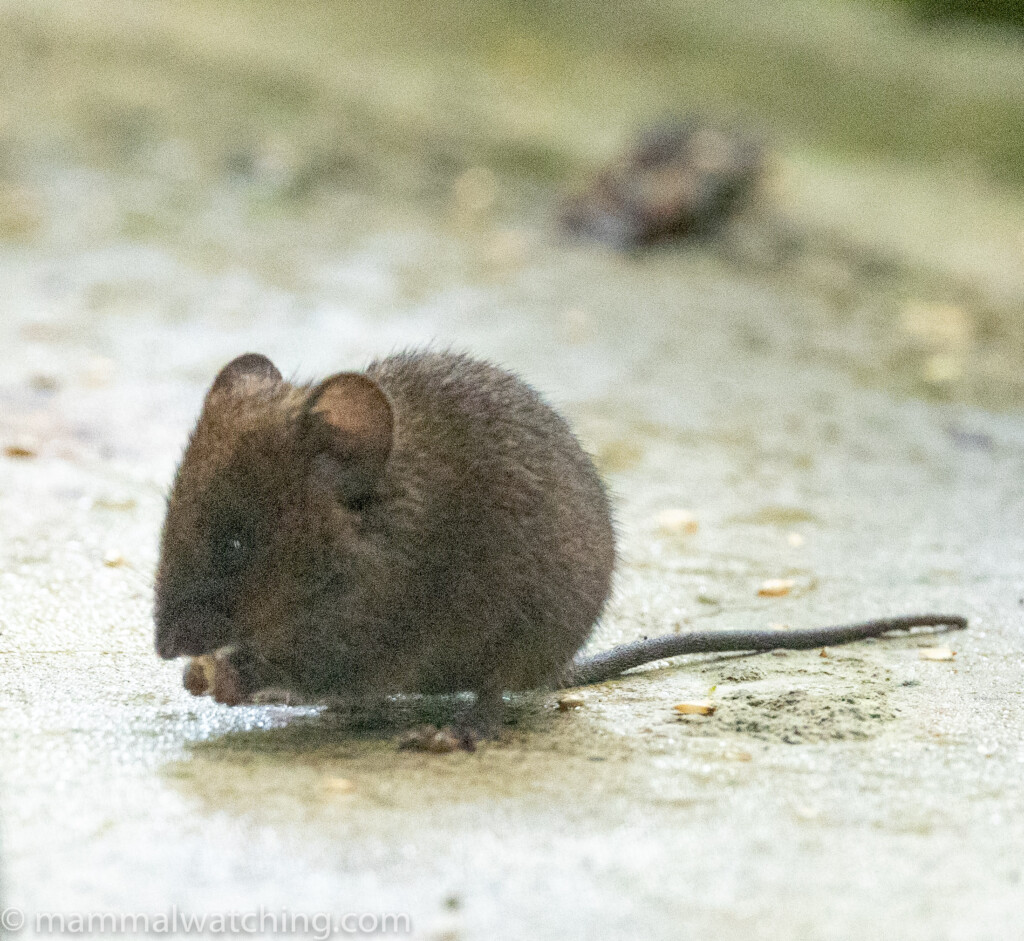
Chiriqui Singing Mouse, Scotinomys xerampelinus
We also saw Quetzals close to our cabin several times.
The small trapping was excellent again, as it often is in cloud forest.
Over two nights I caught two harvest mice species.
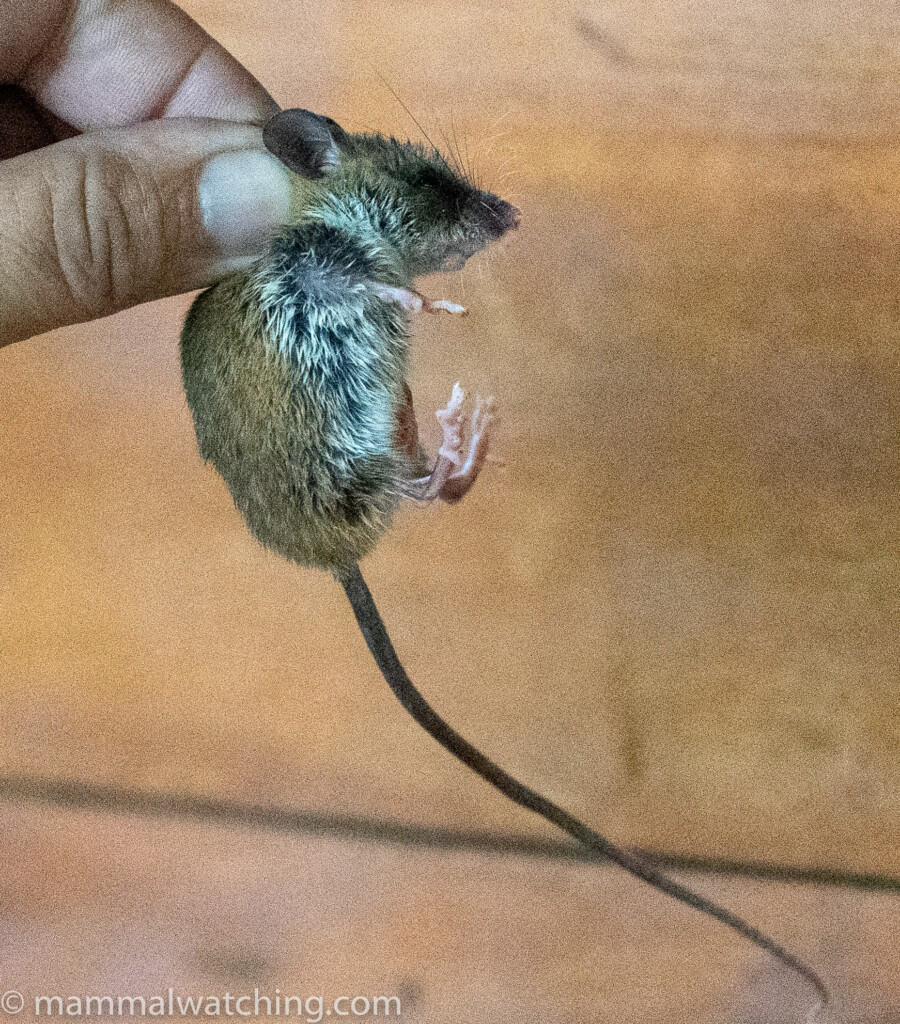
Chiriquian Harvest Mouse, Reithrodontomys garichensis
A small and very long-tailed Chiriquan Harvest Mouse above (which I caught in 2016) and the larger Talamancan Harvest Mouse (below).
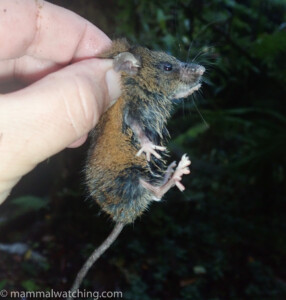
Talamancan Harvest Mouse, Reithrodontomys creper
I caught several Talamancan Deermice, which I also caught here in 2016.
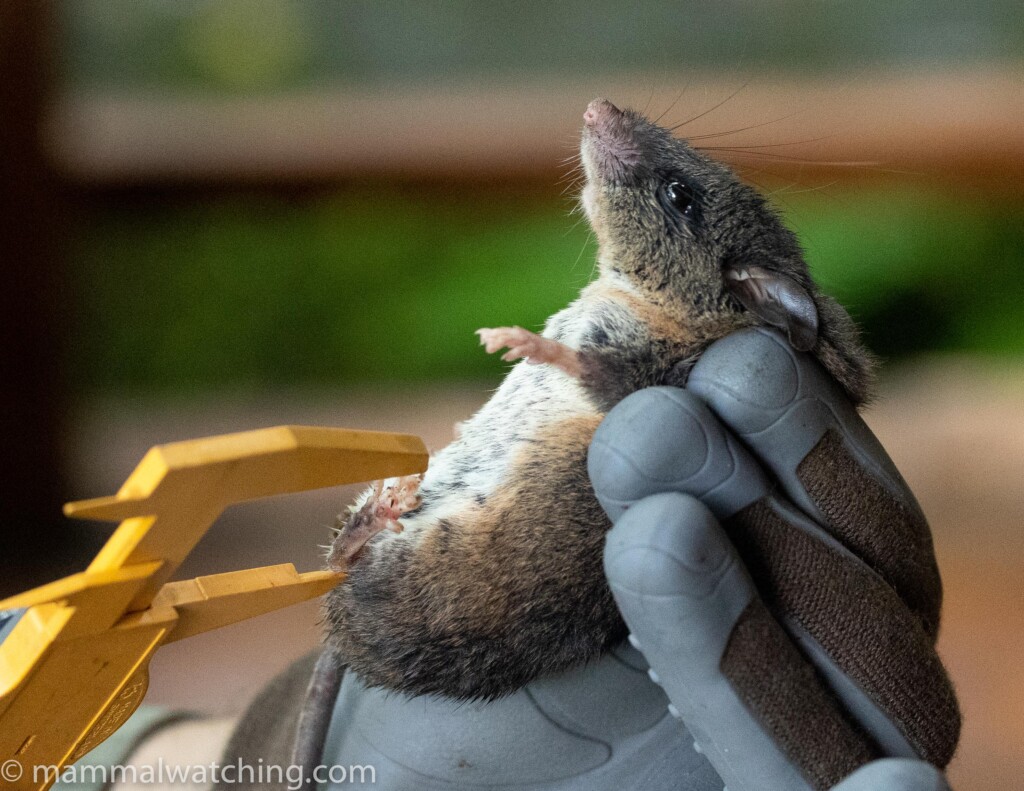
Talamancan Deermouse, Peromyscus nudipes
As well as a Chiriqui Singing Mouse and a Boquete Rice Rat another species I had caught here in 2016.
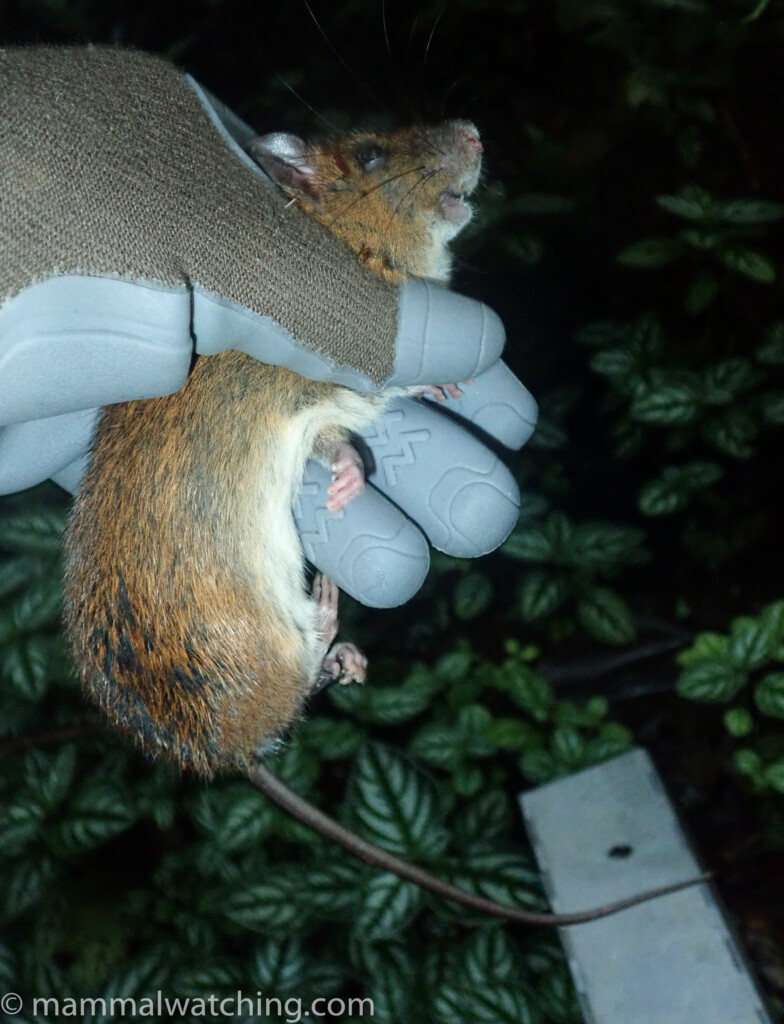
Boquete Rice Rat, Nephelomys devius
But best of all was a large long-tailed rat. Fiona Reid, who helped identify the other species, was cautious at first: but after discussion with others it looks like it probably was the very rare Harris’s Rice Water Rat, Tanyuromys aphrastus.
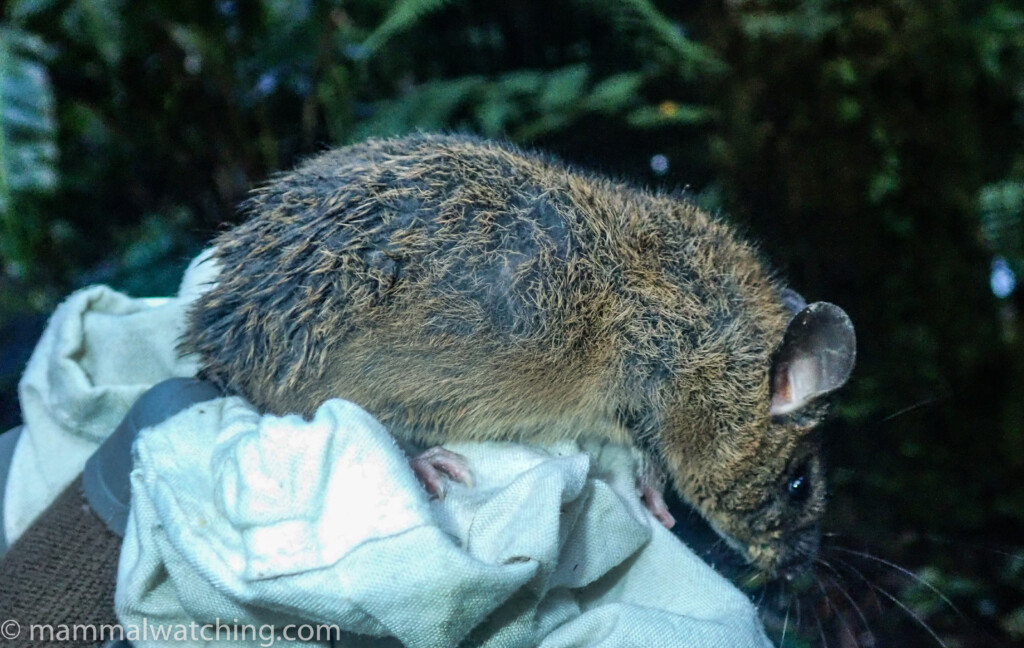
Harris’s Rice Water Rat, Tanyuromys aphrastus
Fiona has never caught the species, which is known only from a handful of records. And so I wish I had taken more careful pictures. And though no one would guarantee the ID without DNA given its rarity, the large size; colour (with a buff belly); woolly fur; relative tail length (with a tail of 155mm and a head-body length of 110); and location (at 2200 metres in Western Panama, caught next to a stream) are all strongly suggestive of the ID.
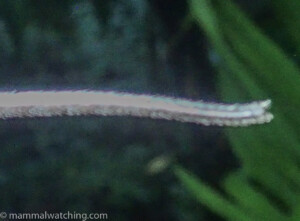
Harris’s Rice Water Rat, Tanyuromys aphrastus: tail tip
As is this bad photo of the small tuft of fur at the end of its monocolour tail.
So I am claiming it. If anyone is heading back that way please let me know and I can explain exactly where I caught this one.
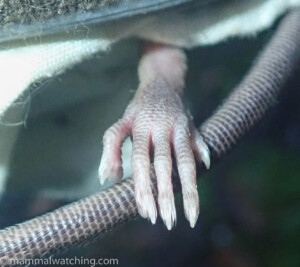
Harris’s Rice Water Rat, Tanyuromys aphrastus: hind foot
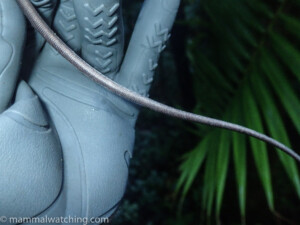
Harris’s Rice Water Rat, Tanyuromys aphrastus: long monocolour tail
El Valle
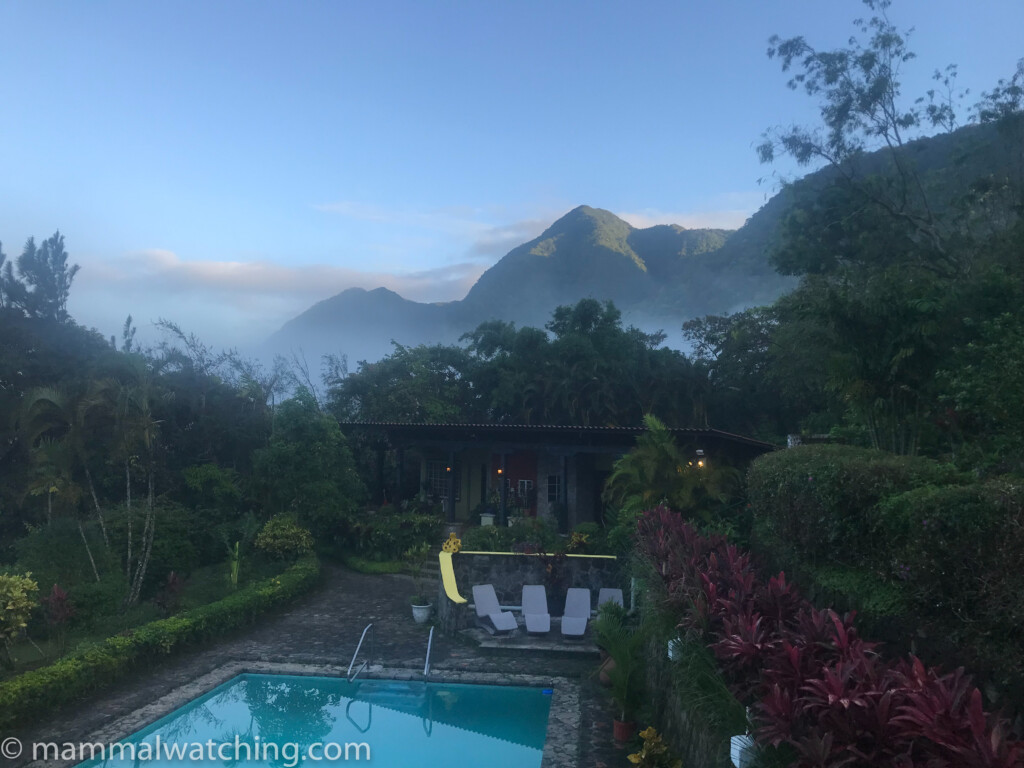
We spent a night in El Valle to break the drive between Coiba Island, where we had been diving, to Panama City. We stayed at the lovely Golden Frog Inn.
A Two-toed Sloth was in the garden, along with many Black Rats that were nesting in a trash pile under a tree.
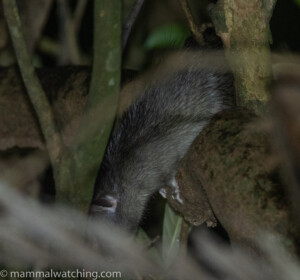
Black Rat, Rattus rattus
In the morning there was a Variegated Squirrel above my room.
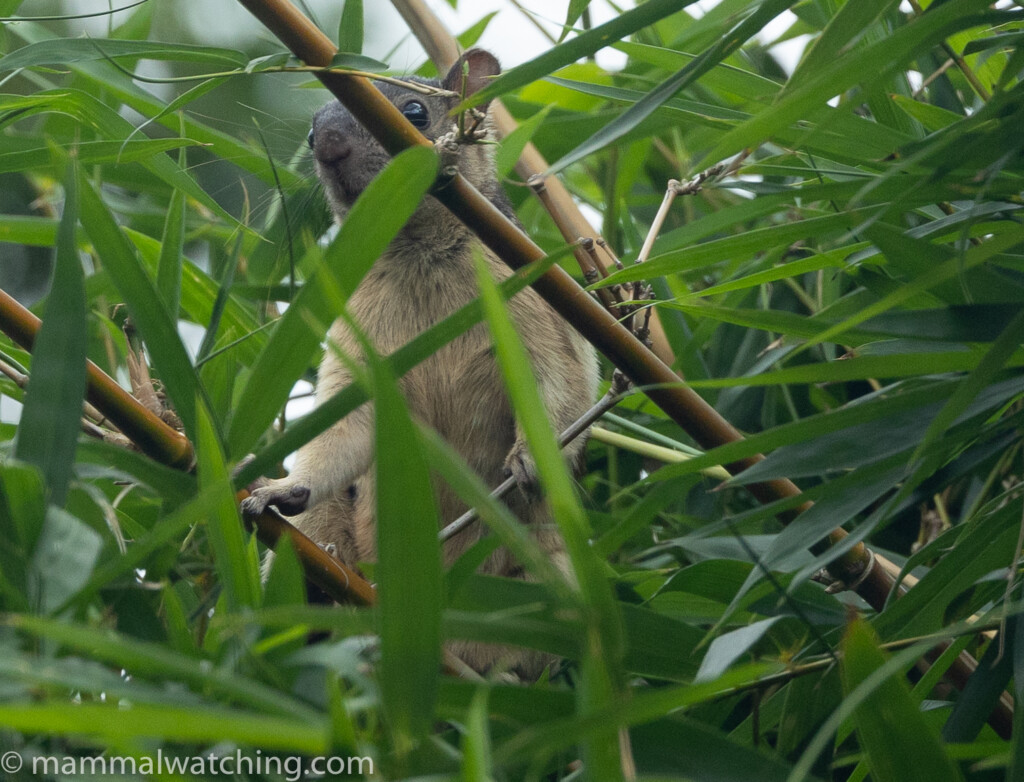
Variegated Squirrel, Sciurus variegatoides
After rereading the Travelling Naturalists’ Report – after I got home – I realised that the area above El Valle is good for Western Pygmy Squirrels. I suspect my mates were happy I didn’t discover this while we were there.
Gamboa
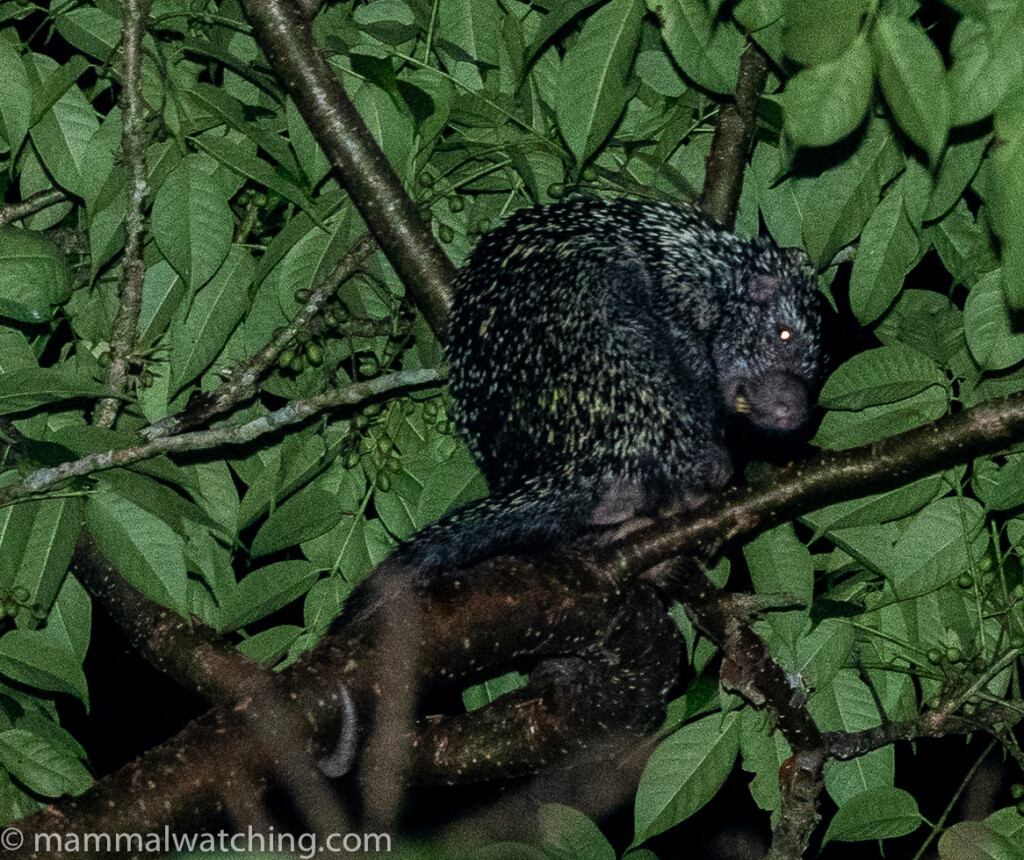
Andean Porcupine, Coendou quichua
Inspired by Paul Carter’s recent report I spent a couple of nights on my own at the end of the trip in the very large and almost totally empty Gamboa Rainforest Resort.
My main target was an Andean (or Quichua) Porcupine (formally Rothschild’s Porcupine). I found one easily with my heatscope while driving along the highway a few km south of the Rainforest Resort (well before the turn off to Plantation Road). Heatscopes are fabulous for finding porcupines.
My other target was a Panamanian Mouse Opossum. I walked the La Laguna Trail at the resort both nights in search of mouse opossums, but without any luck. I did have partial views of a “kinkalingo” (probably a Kinkajou); a largish rat (probably a Tomes’s Spiny Rat); and a Two-toed Sloth.
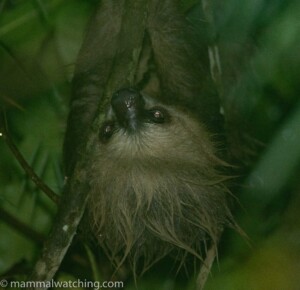
Hoffmann’s Two-toed Sloth, Choloepus hoffmanni
Several night roosting bats, found with my heatscope, seemed to be Seba’s Short-tailed Bats.
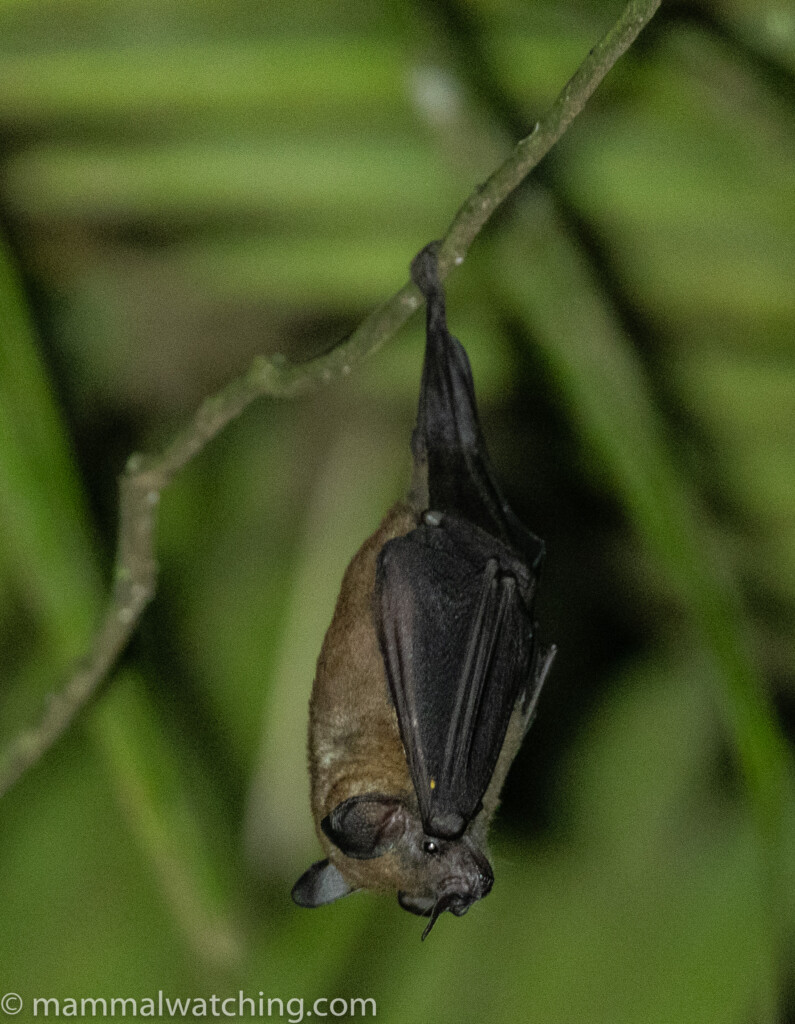
Seba’s Short-tailed Bat, Carollia perspicillata
I picked up some heat from rolled up leaves (heliconia leaves maybe) and checked inside. Sure enough three disc-winged bats – presumably Spix’s Disc-winged Bats – flew out.
Spix’s Disc-winged Bat roost
Driving and walking the resort roads after dark produced several Gabb’s Cottontails and a Woolly Opossum.
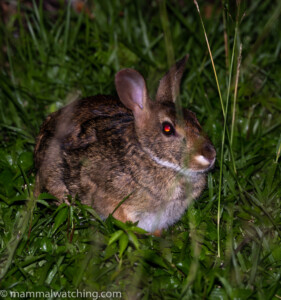
Gabb’s Cottontail, Sylvilagus gabbi
As well as a Common Opossum.
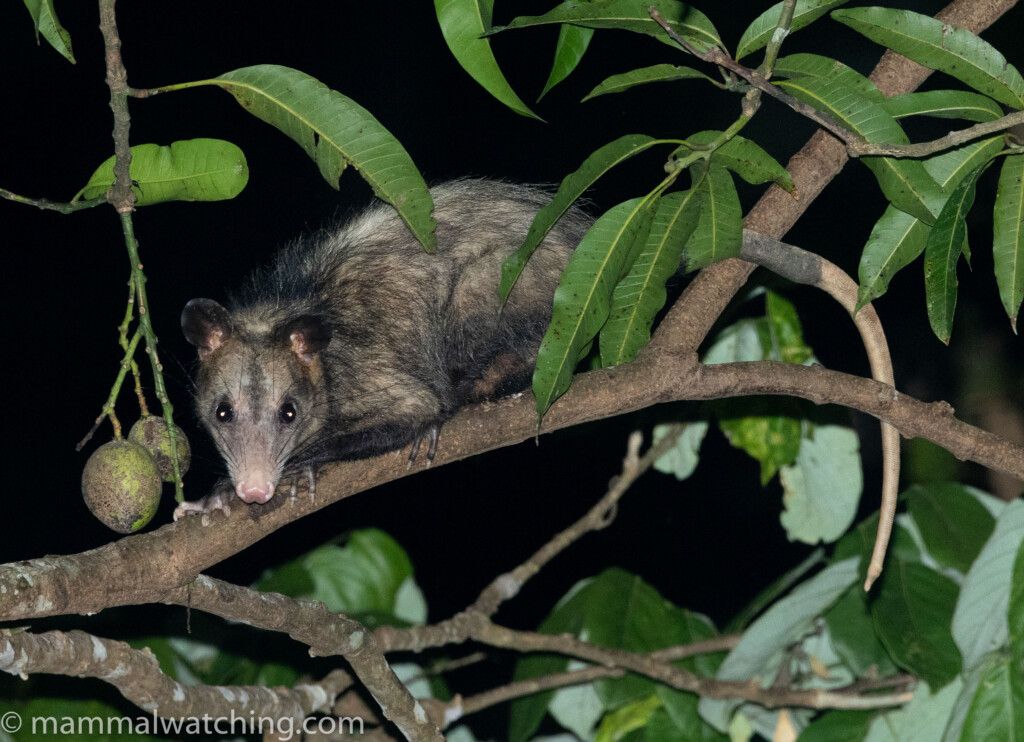
Common Opossum, Didelphis marsupialis
In the late afternoon I saw several Central American Agoutis close to the hotel, and a Collared Peccary crossed the road.
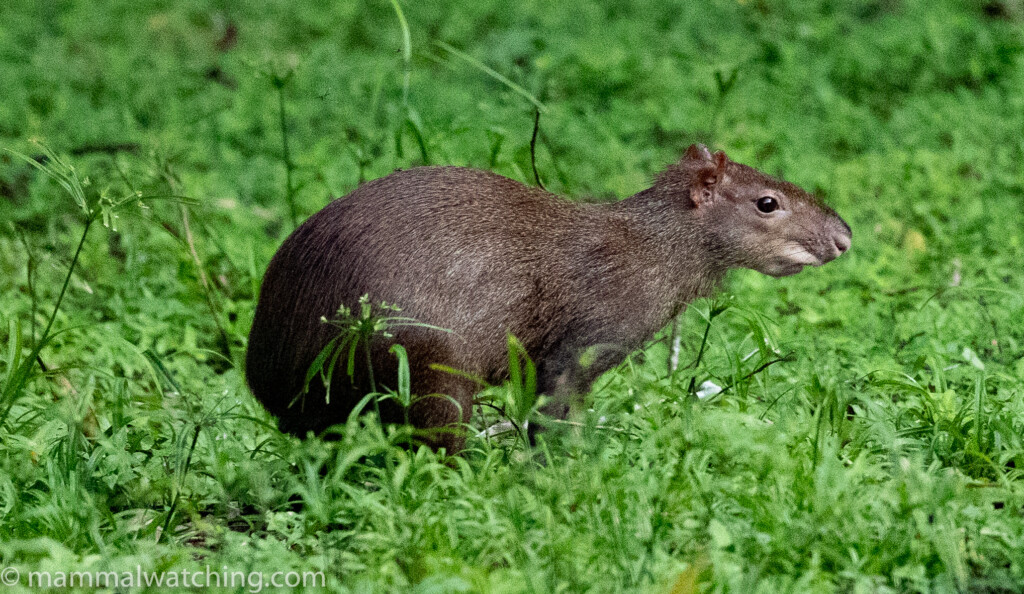
Central American Agouti, Dasyprocta punctata
I started to walk the Pipeline Road one afternoon but torrential rain put an end my stroll. But not before I had seen a Panamanian White-throated Capuchin and heard Mantled Howler Monkeys.
Miraflores Locks
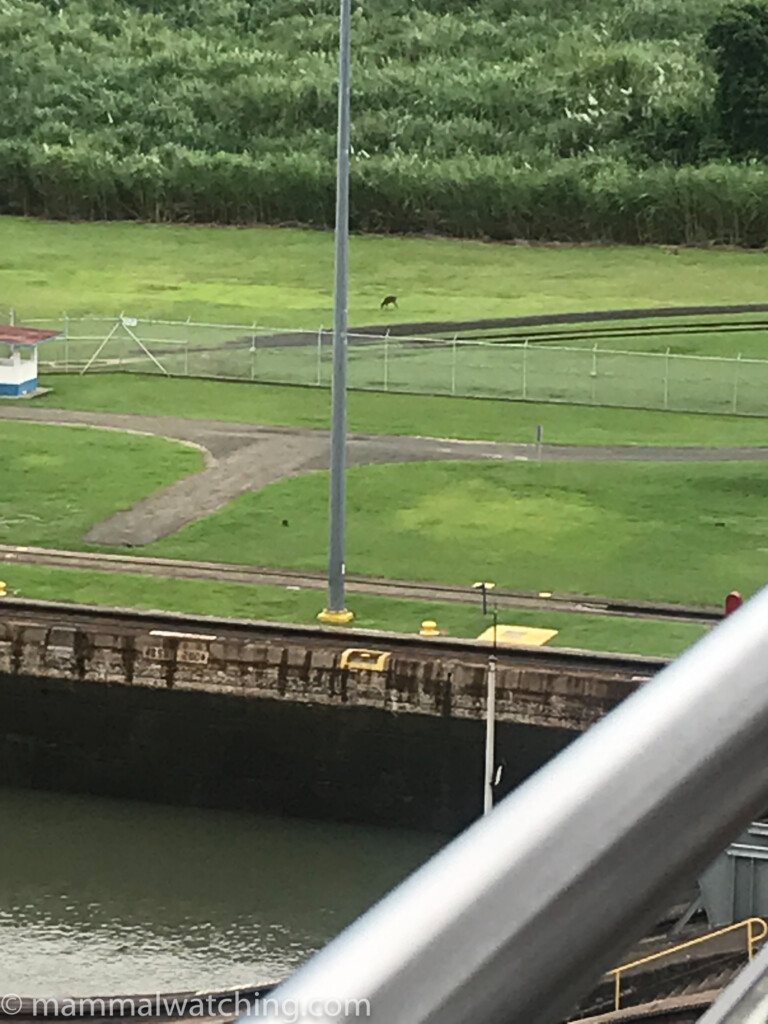
Spot the Brocket Deer
The biggest surprise of the trip was a late afternoon visit to see the Miraflores Locks along the Panama Canal very close to Panama City. It is a popular tourist attraction and we were there just before closing.
Standing in the viewing area in the visitor centre, my eyes wandered over the supertankers crawling through the lock, and landed on a small deer grazing in the open on the other side of the canal. My first Central American Red Brocket Deer. I only had my phone and no binoculars. I suspect this is a reliable spot for them given the security around the canal it would be a brave – or particular stupid – poacher who tried to bag a deer.
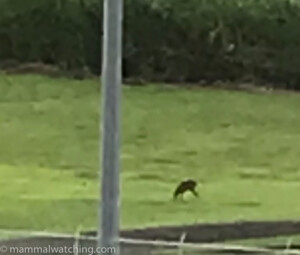
Central American Red Brocket, Mazama temama
Thank you to Luqman, Sion and Mike for their patience and even interest (at times) in the mammals. And to Fiona Reid and Bob Timm for their help with rodent and bat IDs.
Trip List
DIDELPHIDAE (2/13)
Central American Woolly Opossum (Caluromys derbianus)
Black-eared Opossum (Didelphis marsupialis)
MEGALONYCHIDAE (1/1)
Hoffmann’s Two-toed Sloth (Choloepus hoffmanni)
BRADYPODIDAE (1/2)
Pygmy Three-toed Sloth (Bradypus pygmaeus)
LEPORIDAE (1/3)
Gabb’s Cottontail (Sylvilagus gabbi)
ERETHIZONTIDAE (1/2)
Andean (Quichua) Porcupine (Coendou quichua)
DASYPROCTIDAE (1/2)
Central American Agouti (Dasyprocta punctata)
ECHIMYIDAE (0/3)
Tome’s Spiny Rat (Proechimys semispinosus) (?)
SCIURIDAE (2/5)
Red-tailed Squirrel (Sciurus granatensis)
Variegated Squirrel (S.variegatoides)
CRICETIDAE (6/34)
Chiriqui Singing Mouse (Scotinomys xerampelinus)
Talamancan Harvest Mouse (Reithrodontomys creper)
Chiriqui Harvest Mouse (R.garichensis)
Talamancan Deermouse (Peromyscus nudipes)
Boquete Rice Rat (Nephelomys devius)
Harris’s Rice Water Rat (Tanyuromys aphrastus)
MURIDAE (1/0)
House Rat (Rattus rattus)
CEBIDAE (1/3)
Panamanian White-throated Capuchin (Cebus imitator)
ATELIDAE (1/3)
Mantled Howler Monkey (Alouatta palliata) (H)
THYROPTERIDAE (1/2)
Spix’s Disk-winged Bat (Thyroptera tricolor)
PHYLLOSTOMIDAE (2/64)
Handley’s Tailless Bat (Anoura cultrata)
Seba’s Short-tailed Bat (Carollia perspicillata)
PROCYONIDAE (1/7)
Cacomistle (Bassariscus sumichrasti)
Kinkajou (Potos flavus) (?)
TAYASSUIDAE (1/2)
Collared Peccary (Dicotyles tajacu)
CERVIDAE (1/3)
Central American Red Brocket (Mazama temama)
26 species and 4 lifers (in bold)
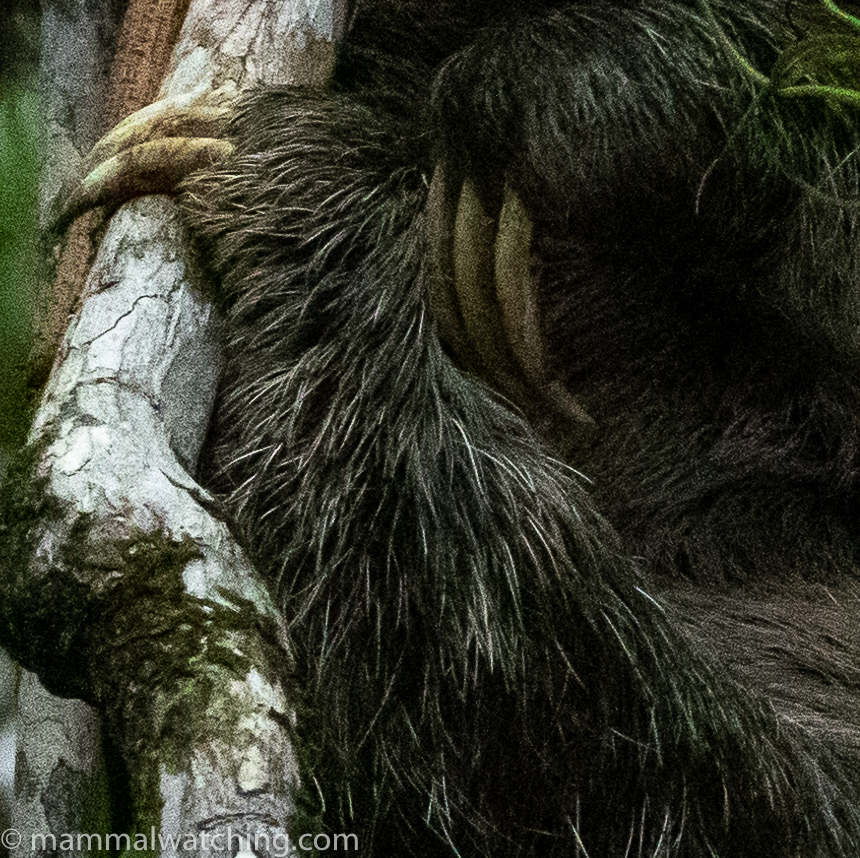
Pygmy Three-toed Sloth, Bradypus pygmaeus
4 Comments
Leave a Reply
You must be logged in to post a comment.


Floyd & Signa Williams
WOW, what a grand trip with a great array of species! We love living vicariously through your adventures! Take care and safe travels!